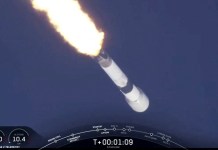The Indian media recently reported that Indian and Chinese military commanders were nearing a ‘breakthrough’ in the negotiations to mutually disengage from the tense situation at the eastern Ladakh border.
F-35 vs F-15: Why Qatari F-15 Eagles ‘Stand No Chance’ Against Israeli / Emirati F-35 Stealth Jets?
The top Indian defense officials were quoted to have said that the two countries were finally proposing to pull-back troops, tanks, howitzers and armored vehicles in the Pangong Tso area.
In the eighth round of high-level military talks that took place on November 6 between the armies of the two countries, Indian media claimed that China had agreed to move its troops back to Finger 8, which was the original position of its troops before April 2020.
The Indian government is also reported to have claimed that the negotiations ended with both sides accepting to declare the Finger 4 and Finger 8 a ‘no-patrol’ zone for both the armies.
US Navy’s ‘Top Aggressor Squadron’ To Get Massive Boost With The Induction Of F-18 Super Hornets
The Indian troops seized control of dominating heights on the strategically important Kailash Range during the night of 29 August, a move that infuriated the Chinese.
The People’s Liberation Army (PLA) has since then been adamant and has persistently demanded that disengagement must begin with the Indian troops withdrawing from the Kailash Range because India has ‘altered the status quo’.

Indian troops rushed to occupy positions on the Kailash Range to deny any further strategic advantages to the Chinese and halt their advances into the Indian territory and prevent them from altering the status quo.
What the Indian media failed to report was that the proposed new agreement entailed a difficult decision for India, which is to withdraw its troops from the Kailash range. The entire Kailash range is being converted into a buffer zone, disallowing the troops from both the sides to patrol it.
According to Lt Gen H S Panag, who has served more than 40 years in the Indian army as GOC in Northern Command and Central Command, “It seems to be a quid pro quo agreement for the PLA to withdraw east of Finger 8 (north of Pangong Tso) and us withdrawing from the Kailash Range.”
How Chinese J-20 Fighters Can ‘Immobilize’ US’ F-35s, F-22 Raptors During A Potential US-China Clash
Writing for The Print, HS Panag says, “It is pertinent to mention that all buffer zones which are likely to be created are on our side of the LAC, denying us the right to patrol, deploy or develop infrastructure, which we had up to April 2020. Given the yawning differential between the military capabilities in China’s favor, this kind of agreement was inevitable.”
He adds that the Kailash Range is one area where the alignment of the 1959 Claim Line offers a major strategic advantage to India, and for the first time since 1962, we are holding it in strength.
“This, negates the strategic advantage the PLA had gained due to its preemptive operations in the Depsang Plains, Hot Springs-Gogra and north of Pangong Tso.”
The two countries had fiercely fought for Kailash Range in the 1962 war, which the Indian troops had to abandon due to lack of force strength and psychological games played by China. Lt. Gen. Panag believes that in 1962, the Indian Army had psychologically collapsed and abandoned the Kailash Range and Chushul Sector when, militarily, there was no need to do so.
Lt. Gen. Panag blames the 1962 withdrawal on flawed strategic planning, weak leadership and lack of reconnaissance efforts by the Indian army to study troop strengths on the other side.
“Today we must not pull back from it merely to declare a political victory. More so, when we gain very little in return. What more can the Chinese want?”, he writes in the scathing article.
Other than its strategic advantages for India, the Kailash ranges are considered holy in the Hindu religion, practiced by the majority of people in India. The ranges stretch from Mount Kailash in Tibet till south of Pangong Tso lake including Rechin La, Mukhpari, Gurung Hills and Magar hills are thought to be about 450 km across.
It would be a fatal mistake to Withdraw from Kailash range now and help out the Chinese. In 1962 also the Chinese were trying to secure the Kailash range. We had Vacated it in panic Because we were then Worried sick about losing Leh. we cant repeat that error
— Maj Gen (Dr)GD Bakshi SM,VSM(retd) (@GeneralBakshi) November 13, 2020
The Indian Army again took control of roughly 60-70 km of the Kailash Ranges along the RechinLa, Mukhpari, Magar and Gurung Hills upto Hainan coast on Pangong Tso lake, on 29-30th August 2020.
The Indian pilgrims used to visit Kailash Mansarovar from Ladakh via Demchok but the route now stands closed after Tibet was illegally occupied by China, which is where the holy abode of Lord Shiva lies now.
The state-based Global Times, essentially the mouthpiece of the Chinese government, quoted its government saying that the two countries were about to implement a disengagement plan under reciprocal principle with the premise that India should firstly withdraw staff who illegally crossed lines on the southern side of the Pangong Tso Lake, which includes the Kailash Range.
It mentioned that the ‘disengagement plan’ reported by the Indian media was not accurate and that India has always had “unrealistic” ideas about the Line of Actual Control (LAC) and disregarded history, “unilaterally believing that Fingers 4 to 8 are its patrolling areas, and has sought to gain bargaining chips in talks by fishing for interests in the disputed border area.”
Why there are contradictory reports by the media groups of the two countries is unknown, however, the Indian side seems to have conceded to withdrawing from strategic positions, which is most likely going to displease the masses in India, and even the pro-government population for the sentimental value attached to Kailash.
Another Indian military expert wrote that it seemed the Modi government “was willing to give away the Kailash range to the PLA on a plater” as a price for taking the September 10 Moscow agreement forward.
There is genuine concern among the Indian political and military analysts that if the strategically important mountain range is lost, the PLA may never let India take it back. So, it’s going to be challenging for the Modi government to maneuver the country out of this deadlock, where it stands between a rock and a hard place.




